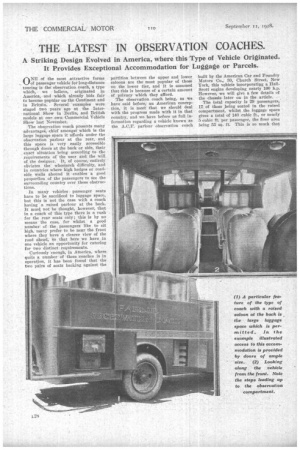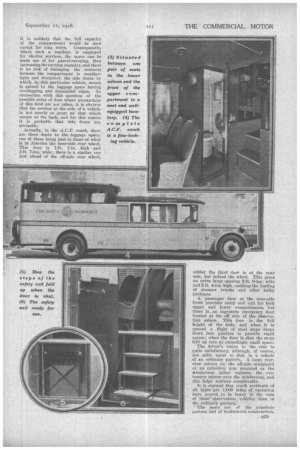THE LATEST IN OBSERVATION COACHES.
Page 12

Page 13

Page 14

If you've noticed an error in this article please click here to report it so we can fix it.
A Striking Design Evolved in America, where this Type of Vehicle Originated. It Provides Exceptional Accommodation for Luggage or Parcels.
OND of the most attractive forms of passenger vehicle for long-distance touring is the observation coach, a type which, we believe, originated in America, and which already bids fair to become popular OD the Continent and in Britain. Several examples were staged two years ago at the International Show in Berlin, and British models at our own Commercial Vehicle Show last November.
The observation coach presents many advantages, chief amongst which is the large luggage space it affords under the observation parlour at the rear, and this space is very easily accessible through doors at the back or side, their exact situation being according to the requirements of the user and the will of the designer. It, of course, entirely obviates the wheelarch difficulty, and in countries where high hedges or roadside walls abound it enables a good proportion of the passengers to See the surrounding country over these obstructions.
In many vehicles passenger seats have to be sacrificed to luggage space, but this is' not the case with a coach having" a raised parlour at the back. It must not be thought, however, that in a coach of this type there is a rush for the rear seats only; this is by no means the ease, for whilst a geed number of the passengers like to sit high, many prefer to be near the front where they have a clearer view of the road ahead; -So that here we have in one vehicle an opportunity for catering for two distinct requirements.
Curiously enough, in America, where quite a numberof these coaches is in operation, it has been found that the two pairs of seats backing against the
partition between the upper and lower saloons are the most popular of those on the lower tier, and it is assumed that this is because of a certain amount of privacy which they afford.
The observation coach being, as we have said before, an American conception, it is meet that we should deal with the progress made with it in that country, and we have before us full information regarding a vehicle known as the A.C.F. parlour observation coach built by the American Car and Fopndry Motors Co.; 30, Church Street, New York, this vehicle iticorporatiag a HallScott engine developing nearly 100 h.p. However, we will give a few details of the chassis later on in the article.
The total capacity is 29 passengers, 17 of these being seated in the raised compartment, whilst the luggage space gives a total of 140 cubic ft., or nearly 5 cubic ft. per passenger, the floor area being 53 sq. ft. This is so much that it is unlikely that the full capacity of the compartment would be used except for long tours. Consequently, where such a machine is employed for shorter services, the space can be made use of for parcel-carrying, thus increasing the earning capacity, and there is no risk of damaging the contents because the compartment is weathertight and dustproof, the side doors by which, in this particular vehicle, access is gained to the luggage space having overlapping and dovetailed edges. In connection with this question of the Possible entry of dust where precautions of this kind are not taken, it is obvious that the suction at the side of a vehicle is not nearly so great as that which occurs at the back, and for this reason it is probable that side doors are advisable.
Actually, in the A.C.F. coach, there are three doors to the luggage space. one of these being just in front of what is in America the near-side rear wheel. This door is 1-ft. 1-in, high and 1-ft. 7-ins, wide; there is a similar one just ahead of the off-side rear wheel, whilst the third door is at the near side, but behind the wheel. This gives an extra large opening 2-ft. 9-ins, wide and 2-ft. 4-ins, high, enabling the loading of steamer trunks and other bulky packages.
A passenger door at the near-side front provides entry and exit for both upper and lower compartments, but there Is, an ingenicrhs emergency door located at the off side of the observation saloon. This door is the full height of the body, and when it is opened a flight of steel steps drops down into position to provide rapid egress ; when the door is shut the steps fold up into an exceedingly small space.
The driver's vision to the rear is quite satisfactory, although, of course, not quite equal to that in a vehicle of an ordinary pattern. A large rearview mirror on the off-side mudguard or an extension arm mounted on the windscreen pillar replaces the. customary mirror over the windscreen, and this helps matters considerably.
It is claimed that coach accidents of all types per 3,000 miles of operation have proved to be lower in the case of these observation vehicles than in the ordinary pattern.
The seats are of the armchair patterii and of basketwork construction. . B29 Reverting to the entrance door at the front, this is controlled from the driver's seat by a ball-bearing, self-locking leverand-rod mechanism.
The headlights are somewhat unusually mounted upon the front wings. They are thus wide apart and serve to indicate to approaching traffic that a coach and not a private car is being met.
There are six plate-glass windows in the lower compartment, allhaving mechanical regulators, whilst in the upper saloon there are six at the sides (these also having regulators) and a large fixed window at the rear. Vision over the roof of the lower compartment is afforded by a well-raked, two-section window between this' roof and that of the upper saloon.
As regards the construction of the body itself, end-grain timber alone is employed for members under stress, all joints connecting pillars to sills, waist rails and roof rails are both notched and bolted to prevent movement. The roof framing, with its heavy built-up ash rail, is reinforced by angle steel. Angle-steel members also extend campletely around each end and well back along the sides. Steel wheel arches are fastened to the pillars, waist rhil and floor members by large steel plates, thus reinforcing the body in places which are usually weak. At nearly every joint. in fact, a steel plate ties the wood. loomhers together. The hardwood roof frame carries five pressed-steel .aull 11 hardwood carlines, whilst longitudinal wood slats, closely spaced, support the
roof. This is of a heavy fabric stretched tiOtly over a fin, thickness of goodquality hard felt, and it is reinforced at the sides with aluminium drip moulding.
It is claimed that this roof, which is known in America as the " soft " type, is entirely free from drumming, The metal panelling at the windows is of 20-gauge (American) sheet aluminium, whilst the panels below the waist rail are of 16-gauge aluminium and the rounded corners at the mar are in 20-gauge steel sheets formed over standard dies.
The plant with which this type of body is manufactured is most modern. Every piece of the entire framing of the body is machined to jig and built up in the same manner as a chassis, the individual pieces also being assembled to jigs.
The chassis employed is a remarkable one with a huge frame, 11 ins, deep and with 3-in flanges. Three tubular cross-members assist in preventing twist through torsional stresses and there are numerous members of channel steel, extensions from which act as body bearers. Flitch plates bridge the crossmembers and bearers. At the front Is a wide, pressed-steel channel riveted to the side members of the frame and carrying a spring bumper. The petrol tank is mounted at the rear between side members and supported by two tubular cross-members.
High-pressure pneumatic 'tyres, 38 ins. by 7 ins. (singles at the front and twins at the rear) are employed.
The Hall-Scott engine has six cylinders of 4i ins— bore and 5 ins. stroke. It transmits its power through a dry multi-plate clutch to a four-speed sliding-type gearbox formed as a unit'with the engine. The propeller shaft is iu three sections, having four Spicer joints of extra large size. A Timken rear axle with underslung worm drive is utilized. The axle is full-floating, the shafts only tilting the drive.
The suspension is exceedingly interesting. 'At the rear, what is known as three-stage springing is employed. At each side there is a main spring 5 ft. 4 ins, long and 5 ins, wide, which under *normal loads takes a slight reverse camber; above this is mounted a supplementary leaf spring, the forward end of which comes into contact with a frame bracket when the vehicle is loaded to the normal extent, but if overloaded or when the vehicle traverses rough roads the other supplementary spring comes into contact with a second frame bracket and stiffens the suspension still further.
Westinghouse air brakes are utilized, the rear wheels having drums 16i ins. in diameter with shoes 6 ins, wide, whilst the front-wheel drums are 171 ins, in diameter with 3-in, shoes, these being of the Bendix three-shoe, self-. energizing pattern. This differs somewhat from the British ideas on braking, as the front and rear brakes are actuated independently of each other, those. at the rear being controlled by a pedal, whilst the front brakes are operated by means of a hand lever.






























